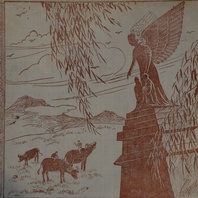
Essay
“Angel of Peace (heping tianshi )”:Icon of Occupation in Wartime China
Henry Fehr’s Allied War Memorial listed here as the ‘God of Piece’ [sic], at some stage in the 1920s (Courtesy of the Historical Photographs of China Collection, University of Bristol).In pre-WWII Shanghai, one of the most recognisable landmarks on the city’s Bund had been Henry Fehr’s art nouveau Allied War Memorial, first erected in 1924, and featuring at its top a statue of a winged Victory. According to Robert Bickers, the monument was so dominant a sight in Shanghai that it made its way into the city’s culture. It even made an appearance in the 1937 film Street Angel (Malu Tianshi), directed by Yuan Muzhi.[1] This may help explain why the statue came to be referred to colloquially in the city either as the “Angel of Peace” (heping tianshi) or the “Victory Angel” (shengli tianshi) during the 1930s. As Paul Bevan has shown, the figure was also utilised in social and political cartoons by the likes of Zhang Guangyu in this same period.[2] The angel is featured overlooking a bucolic scene of water buffaloes, ox herds and willows in an unattributed drawing entitled “Dong Ya heping zhi leyuan” (Paradise of East Asian peace). This image was featured in the pictorial Dong Ya lianmeng huabao (Toa Pictorial) 1.4 (June 1941). Following the Japanese invasion of China in 1937, however, Fehr’s Victory was given a new significance for a variety of Japanese client states. Even prior to the establishment of the Reorganised National Government (RNG) in 1940, for example, the figure was worked into occupation propaganda in eastern China, with the notion of an “angel of peace” resonating with both Japanese client states set up in 1938 which promoted a negotiated peace with Japan, and with Wang Jingwei’s “Peace Movement” (Heping yundong) after 1939. Fehr’s figure was appropriated in the same year as into the cover design for one of the main vehicles for the Peace Movement in Shanghai, the periodical Gengsheng (Rebirth). Under the RNG, Fehr’s figure was transformed into an “goddess of peace” (heping nüshen), and was regularly featured in depictions of the Shanghai streetscape in RNG-sponsored graphic art. Indeed, the RNG “angel of peace” motif into the visual landscape of the RNG well beyond Shanghai, and wherever references to anthropomorphised peace were useful. In some instances, children dressed up as the “angel of peace” when publicly commemorating important dates on the RNG calendar. Elsewhere, Fehr’s monument was re-imagined in rural Chinese landscapes by RNG artists as a harbinger of RNG notions of peace. Unnamed boy dressed as the “angel of peace” (heping tianshi) during celebrations to mark the first anniversary of the founding of the Guangdong Provincial Government under Japanese occupation, May 1942. Ironically, with the “return” of the foreign concessions to RNG rule in 1943, the Japanese ordered that symbols of Western imperialism be removed from Shanghai’s streets. This, of course, included Fehr’s Allied War Monument (with Victory herself being removed, but her plinth left intact). The “angel of peace” thus provides us with an insight not simply into the eclectic origins of many of the symbols adopted by the RNG, and the creative ways in which this regime appropriated pre-war symbols of peace into a wartime cultures of occupation. It also illustrates the limits of RNG autonomy when it came to constructing visual cultures under foreign domination. [1] Robert Bickers, “Moving Stories: Memorialisation and its Legacies in Treaty Port China”, in Max Jones, et al (eds), Decolonising Imperial Heroes: Cultural Legacies of the British and French Empires (London: Routledge, 2016). [2] Paul Bevan, A Modern Miscellany: Shanghai Cartoon Artists, Shao Xunmei’s Circle and the Travels of Jack Chen, 1926-1938 (Boston: Brill, 2016), 267.
Read More
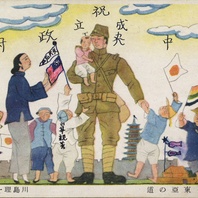
Item
Kagayaku Tōa no michi (The road to a shining East Asia)
This postcard, featuring an illustration by the prolific Japanese artist Riichiro Kawashima, shows a Japanese soldier celebrating “kagayaku Tōa no michi” (the road to a shining East Asia), with Chinese civilians. Of interest here is the fact that the Republican Chinese flag appears to have been drawn onto the postcard (and made to look as if it is being held by the child dressed in white), while other figures in the image hold the “five-coloured flag (wuseqi). The “five-coloured flag” was used by the Reformed Government of the Republic of China (RGROC) up until March 1940, but was replaced by the Republican Chinese flag with the formation of Wang Jingwei’s government. This suggests that the postcard was made prior to March 1940, but used some time thereafter. Text reading “qing zhu xin zhongyang zhengfu chengli” (Celebrating the founding of the new central government) has also been added above the figures, while the phrase “Ri-Hua qinshan” (Japanese-Chinese friendship) has been added to the boy in white.
Read More
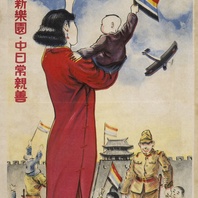
Item
Ertong xin leyuan, Zhong-Ri chang qinshan (New paradise for children; China and Japan will forever be close)
This poster, almost certainly produced with the aim of encouraging civilians in occupied Beijing to embrace Japanese rule, includes many of the standard tropes of early occupied north China propaganda: a “new woman” with a male child; city walls; Japanese soldiers fraternising with Chinese infants; the “five-coloured flag” (wuseqi); and a sky filled with Japanese airplanes.
Read More
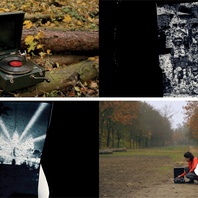
Essay
Bodies of Occupation: Conversation with Estefanía Peñafiel Loaiza
This conversation with artist Estefanía Peñafiel Loaiza will cover her project “Speculations” (on how to enter and exit a forest) (2018), the spectral presence of colonial occupations, and their resonance with present-day political situations Stills from the videos Speculations (2018), courtesy of the artist Participants Zuzanna Dziuban is a 2019-2024 Senior Postdoc on the ERC Consolidator project “Globalized Memorial Museums: Exhibiting Atrocities in the Era of Claims for Moral Universals” at the Austrian Academy of Science. She received her PhD in cultural studies in 2009 at Adam Mickiewicz University in Poznań. She has been a postdoctoral researcher at the University of Konstanz and research fellow at the Amsterdam School for Heritage and Memory Studies, the University of Amsterdam, with a position founded by the DAAD/Marie-Curie cofound program P.R.I.M.E (2015-2017) and a postdoctoral researcher and lecturer at the School for Heritage, Memory and Material Culture, University of Amsterdam, and Freie University of Berlin, iC-ACCESS /HERA “Uses of the Past” Project (2017-2019). Zuzanna has been a Fritz-Thyssen Stiftung fellow at the Humboldt University in Berlin and House of the Wannsee Conference (2012), Alexander von Humboldt Stiftung Fellow at the University of Konstanz and Humboldt University of Berlin (2012-2014), Postdoctoral Fellow at the International Institute for Holocaust Research, Yad Vashem (2013), Postdoctoral Fellow at the Vienna Wiesenthal Institute for Holocaust Studies (2014-2015), and Visiting Scholar at the Institute for Advanced Study, Kulturwissenschaftliches Kolleg, University of Konstanz (2016-2017). Estefanía Peñafiel Loaiza was born in Quito, Ecuador, and works and lives in Paris. She works with different languages and medias (installations, video, photography, actions). Her practice has been constantly motivated by interrogations related to her own displacements and relocations, between her country of origin and the one in which she is established. This situation has driven her to explore, in a wide spectrum, notions such as territories, migrations, frontiers, memory and history, visibility and invisibility (her website).
Read More
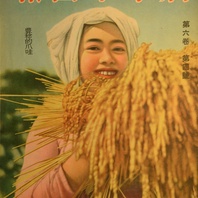
Item
Xin Zhonghua huabao (New China Pictorial) cover, April 1944
This cover from the Xin Zhonghua huabao (New China Pictorial) 6.4 (April 1944) shows an image of an unnamed Javanese woman harvesting rice. Harvesting had been a common theme of propaganda in areas conquered by the Japanese (including Manchukuo and China) since at least the early 1930s. The New China Pictorial was a bilingual (Chinese-English) magazine published from 1939 through 1944 in Shanghai by the occupation journalist Wu Linzhi for distribution in China and throughout Southeast Asia. This magazine employed cover images of women from areas of Southeast Asia that had been occupied by Japan with increasing regularity over the course of 1943 and 1944, having previously focused on Chinese film celebrities.
Read More
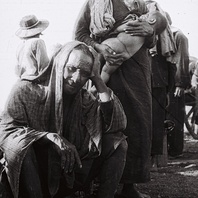
Featured Item
Group of villagers (survivors), Cambodia
This photograph is part of the collection held by the Agence Khmère de Presse (AKP) and the Ministry of Information of Cambodia. This collection, which documents the early years of the People’s Republic of Kampuchea as photographed by the Vietnamese and a small team of Cambodian photographers, has not yet been classified or indexed.
Read More
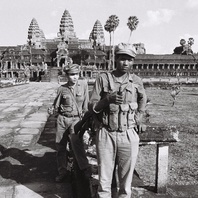
Featured Item
Soldiers at Angkor Wat
This image shows two soldiers of the Kampuchea United Front for National Salvation (KUFNS, also known as FUNSK) [Front or Renakse] posing in front of Angkor Wat. This photograph is part of the collection held by the Agence Khmère de Presse (AKP) and Cambodia’s Ministry of Information. This collection, which documents the early years of the People’s Republic of Kampuchea as photographed by the Vietnamese and a small team of Cambodian photographers, has not yet been classified or indexed.
Read More
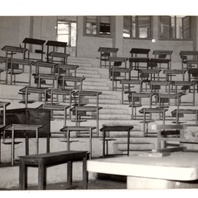
Featured Item
Empty lecture hall
This photograph is part of the collection held by the Agence Khmère de Presse (AKP) and Cambodia’s Ministry of Information. This collection, which documents the early years of the People’s Republic of Kampuchea as photographed by the Vietnamese and a small team of Cambodian photographers, has not yet been classified or indexed.
Read More
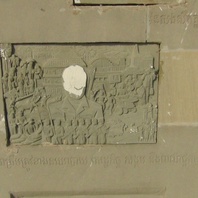
Item
Win-Win Monument carving
This photograph shows a small carving on the 117-metre-long engraved base of the Win-Win Monument. The the central figure in the carving (possibly Hun Sen) has been defaced. The Win-Win Monument complex – photographed here in January 2020 – was inaugurated in December 2018 to mark the twentieth anniversary of the end of the post-Democratic Kampuchea civil war, with the final defection of the remaining Khmer Rouge factions, thanks to the DIFID policy (“Divide, Isolate, Finish, Integrate, Develop”) also known as the “Win Win” policy of Prime Minister Hun Sen.
Read More
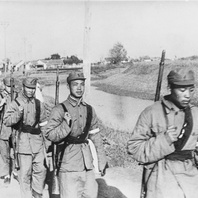
Item
RNG troops by a riverbank
A group of RNG soldiers walks along an unidentified river bank. Possibly part of the Rural Pacification (qingxiang) campaigns.
Read More
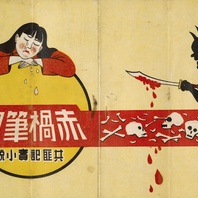
Item
Chihuo biji: Gongfei jishi xiaoshuo(A record of the Red Peril: A novel recording the deeds of the Communist bandits)
This book, almost certainly produced by the Japanese military, tells the story of communist violence against Chinese peasants in wartime Shanxi, and the escape of an anti-communist Chinese peasant girl to occupied Beijing. It was clearly written to discourage civilian support for the communist resistance in north China, and to foster peasant support for the newly-established PGROC early in the occupation. The weeping peasant woman is juxtaposed to the sinister “devil” that is international communism.
Read More
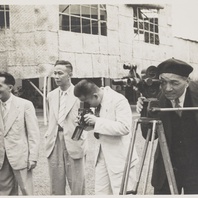
Item
Chu Minyi with film camera
The RNG foreign minister Chu Minyi tries his hand at filmmaking in this undated photograph. Next to him is (possibly) Chen Guoqi (a photographer for the RNG’s Central News Agency). The RNG Minister of Publicity, Mr Lin Baisheng, is on the far left of the image. This image was taken as Chu Minyi filmed a Cabinet meeting convened by Wang Jingwei in the summer of 1940. Newsreel footage of the event can be found here.